November 4th, 2025

Bridgette Meinhold with her title piece, “How the Light Gets In,” outside of her studio
Light has always been a quiet presence in Bridgette Meinhold’s work: diffused through fog, resting on snow, glancing across distant peaks. In her upcoming exhibition, “How the Light Gets In,” opening November 7th at Gallery MAR, that presence steps into focus. The title, drawn from Leonard Cohen’s lyric that “there is a crack in everything, that’s how the light gets in,” became a meditation on openness and connection. For Meinhold, the idea of light entering through a window, both literally and in spirit, speaks to how art itself invites the outside world in. Her paintings, she reflects, have often been described as “an extra window in the house,” an image that resonated deeply as she developed this new series.
In these works, Meinhold continues to explore the atmospheric landscapes that have long defined her practice, yet through new pairings, shapes, and materials, she reveals fresh ways of seeing. Cold wax joins her signature encaustic process, allowing for a richer play of color and texture, and each diptych or triptych feels like a view framed by a window – intimate, luminous, and alive with movement. “How the Light Gets In” offers more than a collection of landscapes; it becomes an invitation to pause, to look outward and inward, and to notice the quiet ways light illuminates, inspires, and stirs something within us.
In the following conversation with Gallery MAR, Meinhold shares the inspirations behind this new body of work, her evolving relationship with materials, and how each painting becomes its own kind of window – one that looks out, and just as meaningfully, looks within.
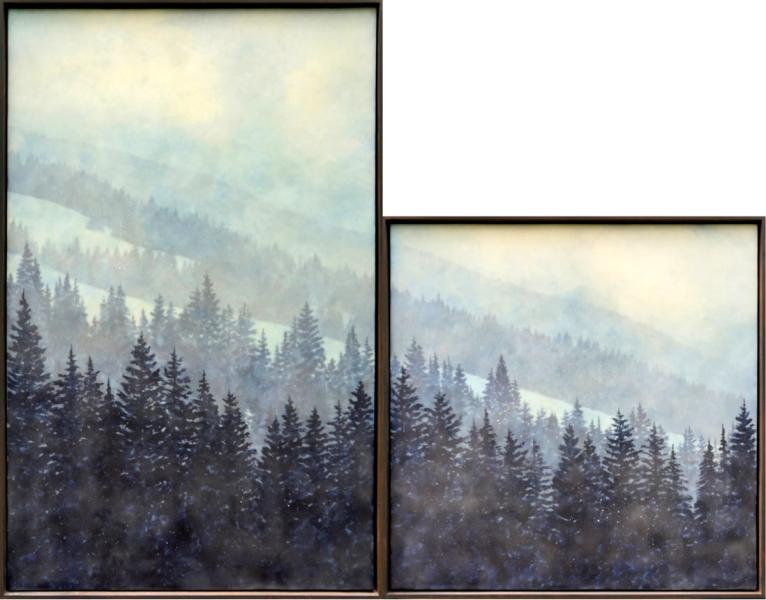
Bridgette Meinhold, “Forget Your Perfect Offering,” encaustic, 47″ x 60″
Gallery MAR: Your upcoming exhibition, “How the Light Gets In,” has such a poetic title. Can you tell us what it means to you and how it connects to the themes in this new body of work?
Bridgette Meinhold: Originally, I was inspired by Maren asking me for a uniquely shaped diptych, and that had me thinking about windows and frames, and unique pairings or groupings. I’ve also had a number of collectors tell me how my paintings feel like they are adding an extra window in their house, and I’ve always loved that idea of an easy to install window – hammer nail, hang painting, presto! But I thought “Windows” as a show title, well, I thought it was rather boring, and what kept playing over in my head was the line from Leonard Cohen’s Anthem – which to me is a poem, but perhaps is actually a song. The line, “How the Light Gets In,” comes from the chorus and goes like:
Ring the bells that can still ring
Forget your perfect offering
There is a crack in everything
That’s how the light gets in.
Now Cohen didn’t always like to explain what his songs meant, but he did give some indication of his meaning, which you can read here. As with all poetry, there is the meaning from the poet and then there is the meaning the reader takes from it. So I’ll give you mine. I think this is about standing up for what you think is right, and about trying to find hope and joy wherever you can. We’re not going to get it perfect, but that doesn’t mean we shouldn’t try. It applies to everything – the moment we are living in as a nation, the work we do for our jobs, and the life we lead personally, alongside our friends, family, and community. The light that shines through the cracks to show what needs to be done, so now go make an effort. Do something, anything.
So to be very literal in the meaning of my show – windows let light in. In a way, they are the “cracks” in a building – they let the light in and let us see out. Windows are portals that transport us, challenge us, and motivate us to action. I mean, how often have I woken up excited to see how much snow we got, inspiring me to go outside and ski!
I also like to read a lot of poetry, so all the painting titles come from poems that I felt had similar themes or ideas as to what I was trying to show. That being – live your life, go make what you want to see in the world, don’t be perfect about it, but just get out there and try.
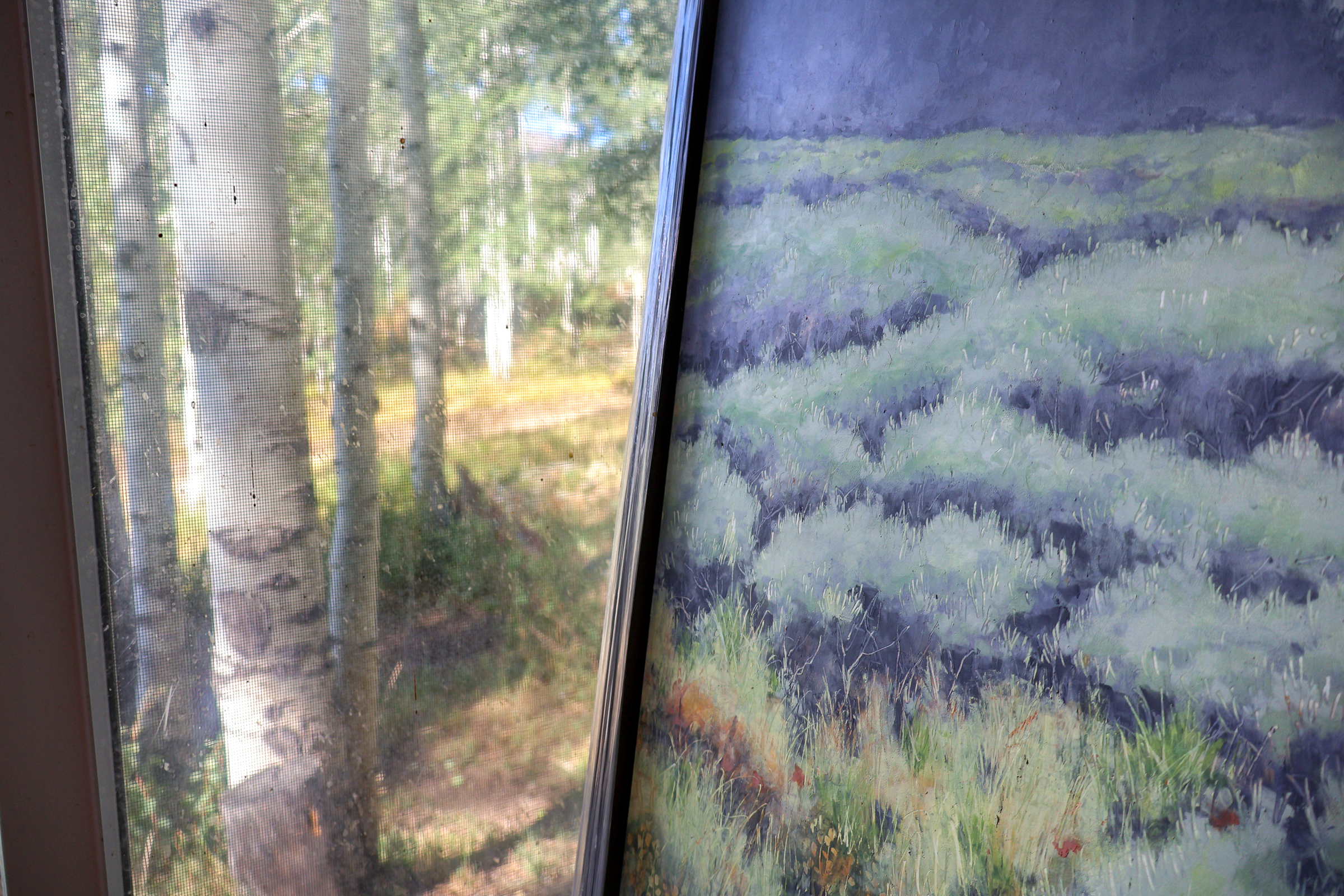
A detailed shot of Meinhold’s cold wax work “Let Me Drink the Day” next to the aspen tree view outside her studio window
Gallery MAR: Beautifully said! What can our collectors expect to see from these new “windows” in this new series? How does it build upon — or diverge from — your past work?
Bridgette Meinhold: Every new painting I make builds upon the last painting I made. Each one is part of a long evolution of learning, experimenting, improving, and changing. I think collectors will see a lot of my history in these paintings, what I am most known for – my atmospheric landscapes, but there’s a twist. I’m looking at old ideas from a new angle, perhaps from a different window of the same house. I’ve also done a number of diptychs and triptychs before, but these new groupings are really interesting to me, and I liked playing around with how I could envision windows in a house looking out onto a landscape. I hope to do more like these – ensuring that each panel is its own painting that could be viewed on its own, but is part of a larger whole. Also, there’s a fair bit of color, which has been a lot of fun and exciting for me.
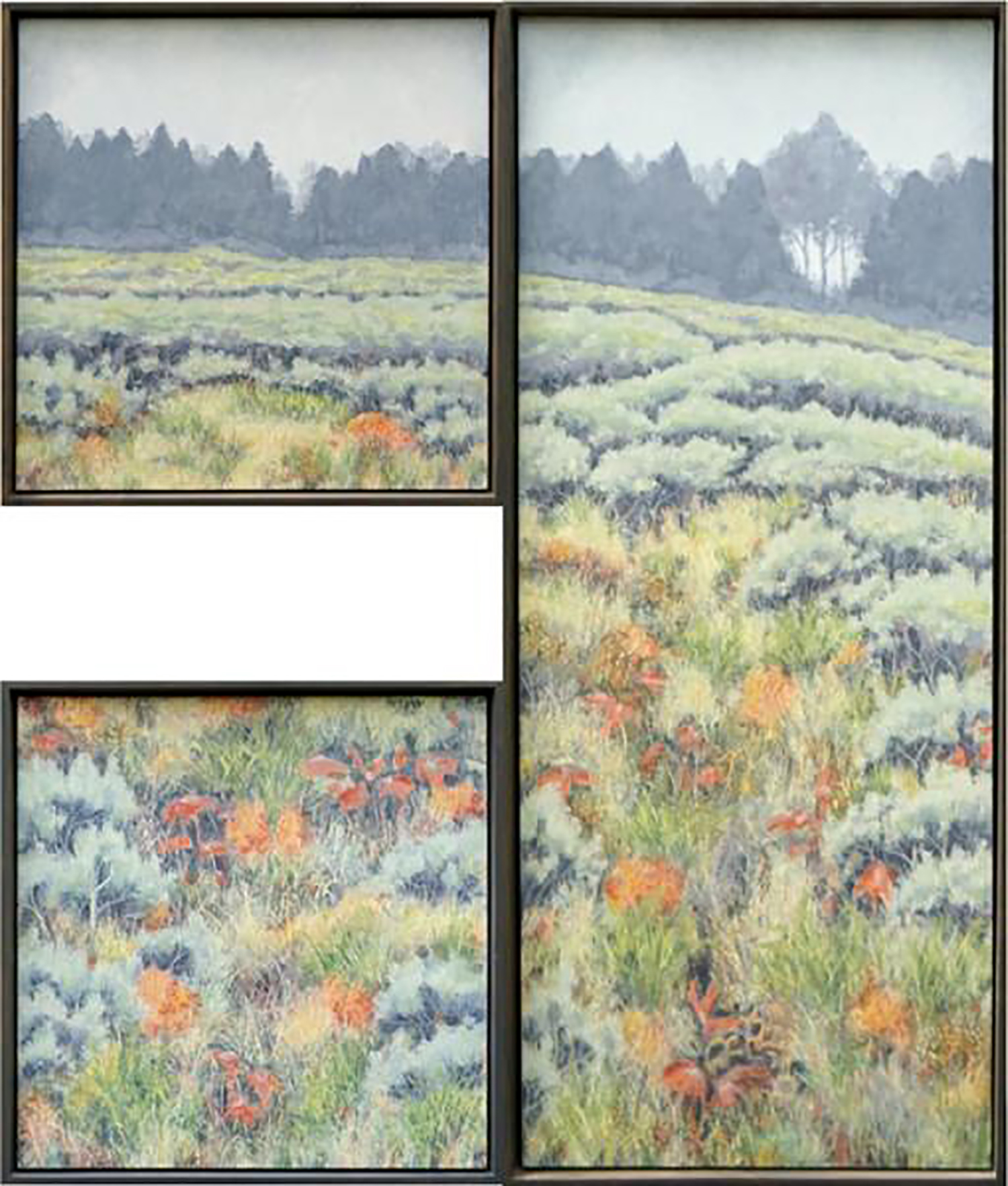
Bridgette Meinhold, “Let Me Drink the Day,” cold wax, 47″ x 40″
Gallery MAR: In addition to uniquely shaped pairing and color, your latest work also introduces cold wax painting to your practice — an exciting evolution from your well-known hot wax encaustic works. What first drew you to experiment with cold wax?
Bridgette Meinhold: I can’t remember where I first learned about cold wax, but I was intrigued by it after seeing some of the work from Salt Lake City artist, Stacy Phillips, who also teaches wonderful workshops in mixed media. So I took a workshop with her in the fall of 2023 and really loved it, and because it’s also made with beeswax, it felt right up my alley. I love that there’s a lot of similarities between cold wax and encaustic, especially the layering process. But I was also intrigued by the ability to add color in a way that I can’t quite do with encaustic. I was also running into the problem of having ideas for paintings that I couldn’t make easily with encaustic, so I had been exploring with some other mediums, long before the cold wax, to try and make what I envisioned in my head.
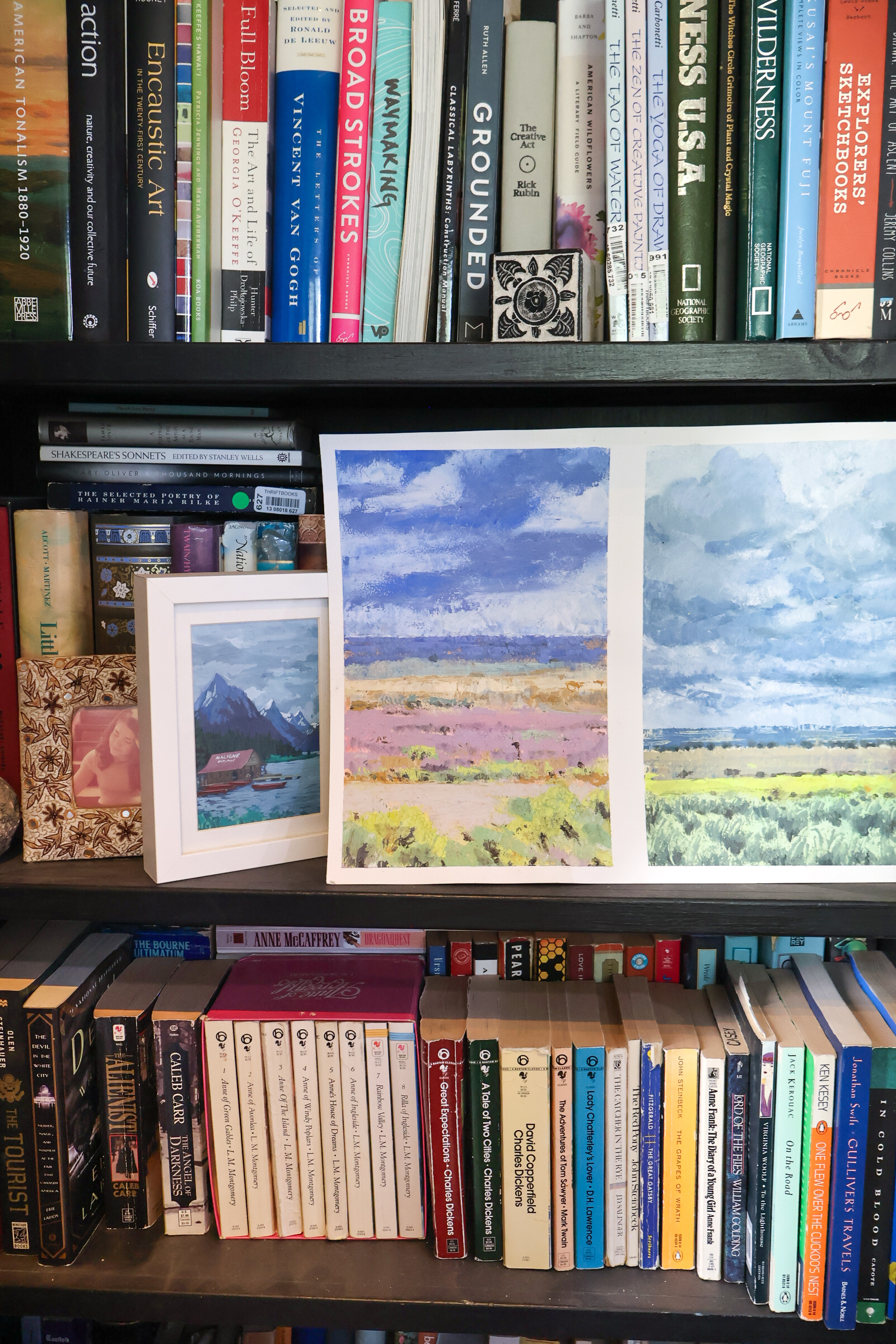
A few watercolor studies by Bridgette Meinhold in her home
Gallery MAR: How does the experience of painting with cold wax differ from your traditional encaustic process?
Bridgette Meinhold: Cold wax is made when you melt together beeswax with a solvent, and when it cools, it becomes the consistency of lard. Some oil painters use cold wax medium as an additive to their paints to thicken it up or maintain texture. Cold Wax artists add oil paint to their wax to give it color. Meanwhile, encaustic is beeswax mixed with damar resin, that is heated to around 200 degrees F and then is painted or applied in this “molten” stage. So the process is actually very different. Cold wax has no heat, no skillets, no torches, and it is often applied with palette knives, scraping tools, and brushes. But you can basically do the same things with them – layering, collage, scraping into them, mixed media, and a lot more. What I like about both of them is how geological or perhaps archeological they are. The best paintings, in my opinion, are a build up of time and energy with layers, and you can dig into them or look through them, as though you were exploring the painting’s history.
Gallery MAR: Has it changed the way you approach layering, texture, or atmosphere in your work?
Bridgette Meinhold: Yes, but I can’t say for certain how yet. My encaustic process is very formulaic, meaning, I know it well, and I know what steps to take to achieve the results I want. With cold wax, I am still learning, which is honestly, so fun. More so, I can say that I am seeing landscapes and nature in a new way, and appreciating color, texture, depth, and composition with more nuance.

Bridgette Meinhold, “Signs for All to See,” cold wax, 40″ x 60″
Gallery MAR: Do you see yourself continuing to explore both mediums side by side, or do they fulfill different creative impulses for you?
Bridgette Meinhold: Some days I think that I could switch completely to cold wax and be able to say everything I want with paintings and never be bored for the rest of my life, but then other days, I feel like the encaustic is still the way to go. So until then, I will be working with both mediums. It’s fun to play them off each other and I keep learning more from both of them. Right now, it’s not about either/or, it’s about both.
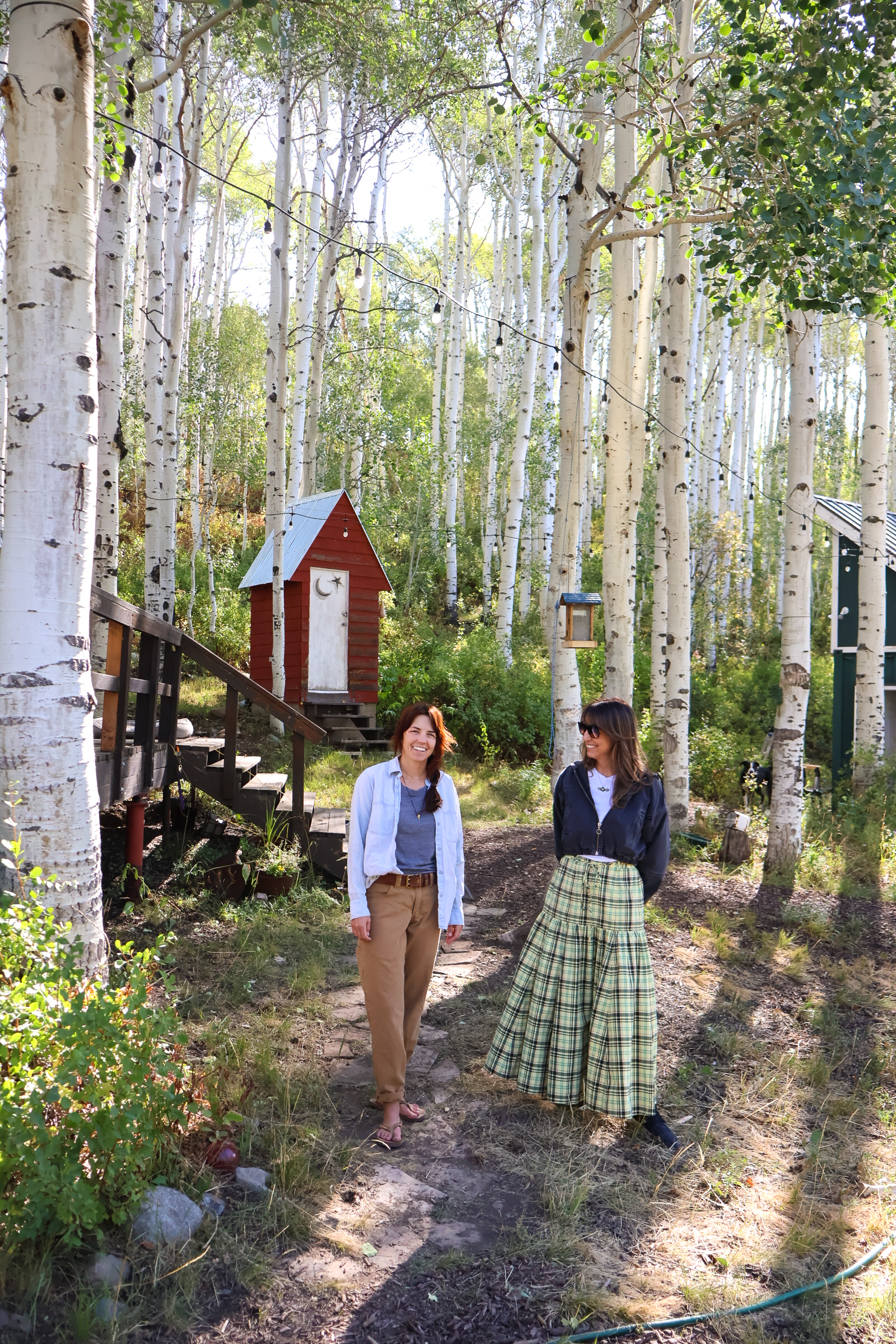
Bridgette Meinhold offers a tour of her home and studio, up in the mountains of Guardsman’s Pass
Gallery MAR: Your work has long captured the serene quiet of snow-laden forests and mountain peaks. Lately, though, you’ve begun to paint alpine meadows, sagebrush plains, and verdant valleys. What inspired this shift in subject matter?
Bridgette Meinhold: I’m a plant girl. I love wildflowers, sage, and grasses. And I still love trees. I love anything that grows really, although I don’t have a great green thumb. So the easiest answer is that these paintings are just a love letter to plants.
I just remembered a painting I tried to make after I was back from living abroad in Europe. I was living with my parents in Oklahoma while I applied for grad school, and I was painting again, while road biking for exercise. And while riding past all these wheat fields, I became so mesmerized by them, and the concept of farming and growing plants, tending to them, and I tried to capture it all on this giant canvas with this big vast blue sky. I never finished the painting, but it’s still in my heart, as though it were finished, so I think it’s about roots, both literal and ancestral roots, and also about being grounded and tapping into earth’s energy.
It’s also about noticing what’s right next to us, about what’s at our feet and within our grasp. And of course, everyone loves the majestic and aspirational mountain in the distance, but I also want to appreciate what’s below and all around me, things I can touch and smell and get up close and look at – essentially, the right here and now. We can’t know what will happen in the distance or the future, and we can only remember what happened in the past, but if we pay attention, we can see and feel what’s happening right around us.
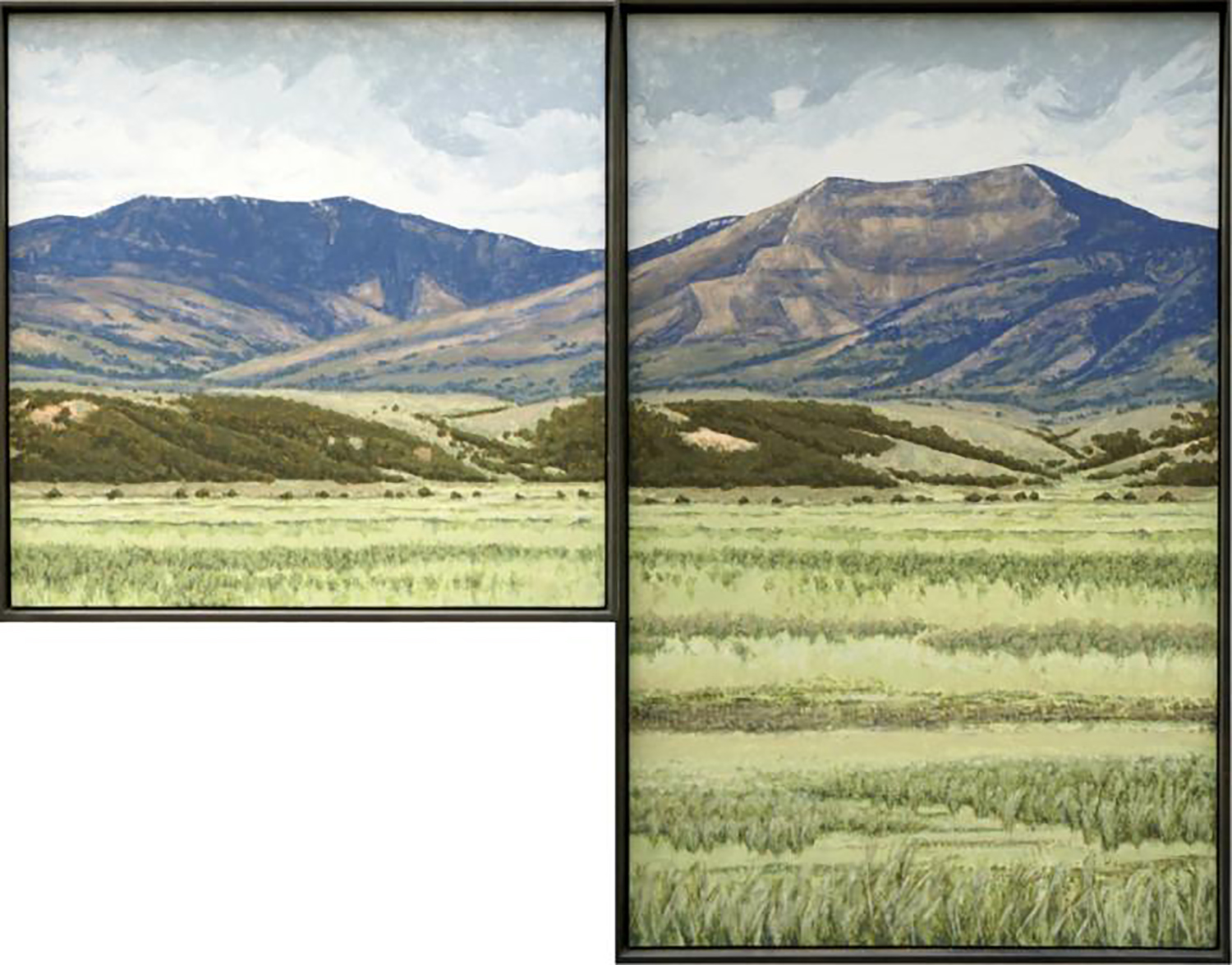
Bridgette Meinhold, “The Orderliness of the World,” cold wax, 47″ x 60″
Gallery MAR: How does painting these more varied and seasonal landscapes feel different for you as an artist?
Bridgette Meinhold: With my encaustic process, I know the steps. It’s a dance I have practiced many, many times, and it feels good. But I also really like learning new things, and it’s good to feel like a beginner again, and see ideas through a new lens and a new perspective, which keeps things fresh. I have no idea where this journey will take me and I don’t even have a direction I’m headed with it yet. Every day I have another idea for a new painting, a new way of painting, new colors to try, and variations on themes to experiment with. It’s just exciting to always have new ideas, even if I never get to execute them, which is honestly the biggest problem I have – not enough time to make all the work I want.

Bridgette Meinhold alongside one of the panels of her triptych “Portal III” in her studio
Gallery MAR: As you look ahead, what excites you most about where your work is headed? Are there ideas or directions you’re eager to explore next in the studio?
Bridgette Meinhold: What I’m probably intrigued by the most right now though is how to make work that looks like my watercolor sketches with the cold wax. And how can I use the white of the background just like you use the white of the paper, by thinning out the color of the paint with the wax, just like I would use water to make a less saturated wash with watercolor. This is a technique I am working on and need more practice, but I think it can be done.
However, I’m most excited about the possibilities of what lies ahead. If I could look into a crystal ball 5 or 10 years ahead, I probably would be blown away by the direction I took. My theory is to just keep following my curiosities down the rabbit hole. I make a lot of work that no one ever sees as I experiment or try out new ideas, and they all seem to have potential. At some point, I guess I’ll have to choose a route, but until then, I’m going to try them all.
Written by Veronica Vale and Bridgette Meinhold
 The View Through the Window: A Conversation with Bridgette Meinhold
The View Through the Window: A Conversation with Bridgette Meinhold Happy Howl-o-ween!
Happy Howl-o-ween! Nina Tichava at the AMoA Biennial
Nina Tichava at the AMoA Biennial